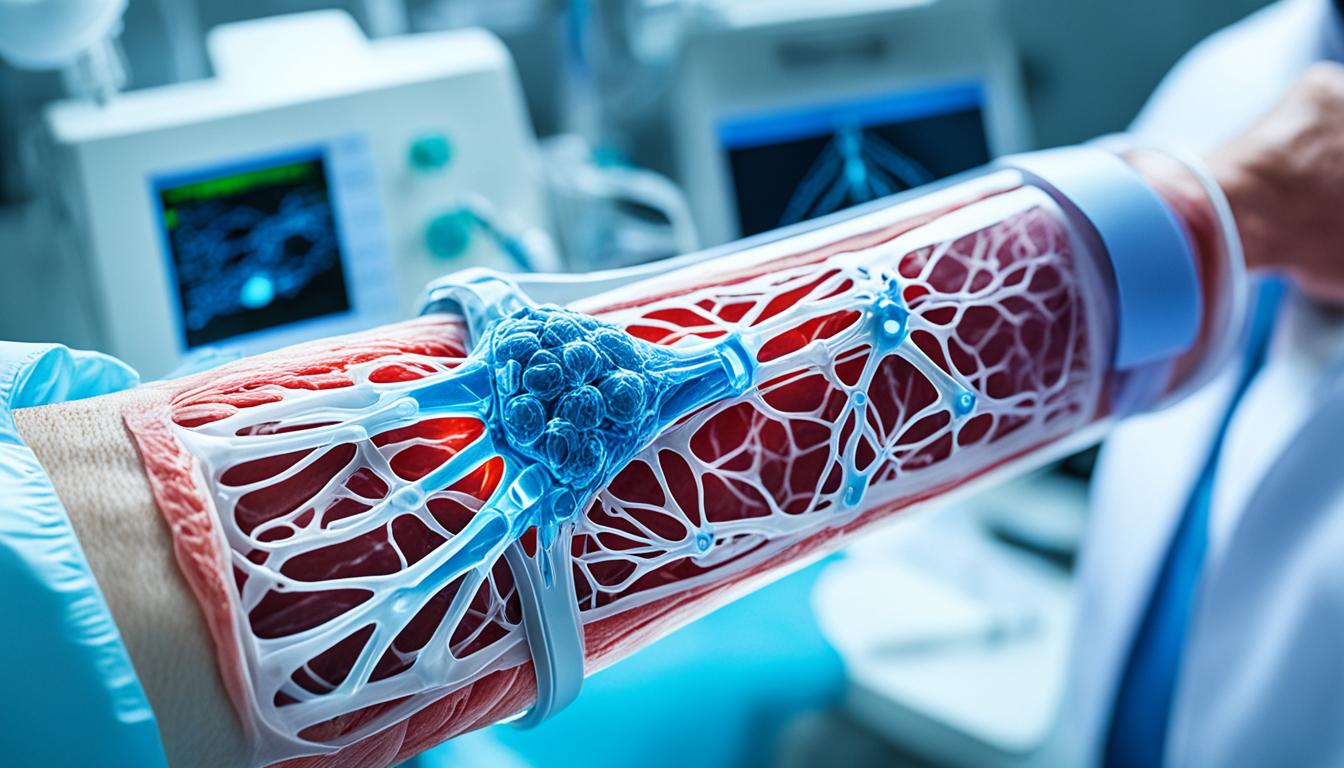The brachial plexus is like a nerve highway from the spine to the arm and hand. Injuries happen when these nerves get stretched, compressed, or torn. This can be from sports, childbirth, or even accidents. Signs of an injury vary, from a mild stinging feeling to severe pain and weakness. If these symptoms stick around, it’s important to see a doctor.
Advanced treatment like stem cell therapy offers hope for those with brachial plexus injuries. It works by injecting stem cells into the damaged area. This helps the body heal and can restore nerve function.
Key Takeaways:
- Brachial plexus injuries can be due to nerve stretching, compression, or tearing.
- They show up as anything from mild stingers to severe pain and weakness.
- Sports, childbirth, and accidents are common causes.
- Stem cell therapy is an advanced treatment that looks promising in boosting nerve healing and function.
- If symptoms persist, it’s essential to seek medical help.
Understanding Brachial Plexus Anatomy and Types of Injuries
The brachial plexus is a network of nerves starting from the neck’s spinal cord. It includes five nerve roots: C5, C6, C7, C8, and T1. These roots join to form trunks, divisions, and cords, controlling your shoulder, arm, and hand movement.
Injuries to the brachial plexus can happen from trauma, sports, accidents, or health issues. The injury type depends on the damage’s location and severity. Here are some common brachial plexus injuries:
- Root injuries: These injuries involve nerve roots directly. Reasons can include stretching, tearing, or pressure on the roots.
- Cord injuries: Cord injuries damage the plexus’ key groups of nerves. They affect more areas and can cause complex problems.
- Trunk injuries: These injuries involve one or more trunks of the plexus. The impact varies, affecting a specific arm or shoulder part.
- Nerve level injuries: Nerve level injuries damage specific nerves in the plexus. They often affect just one area and muscle function.
The categorization of brachial plexus injuries is based on the affected nerves and injury level. Each injury type has unique symptoms and needs special care. Knowing the plexus’ structure and injury scenarios is key to handling these injuries well.
Symptoms and Causes of Brachial Plexus Injury
A brachial plexus injury brings on various symptoms. These change depending on how bad the injury is and where it happened. You might feel numb, weak, lose sensation, or have severe arm pain. These issues can really affect your daily life and how you feel.
Symptoms show the damaged nerves. Damage to the upper part (C5-C6) can cause weak or numb shoulder and arm feelings. Hurt to the lower part (C8-T1) may lead to weak or numb hand and finger feelings.
The causes of brachial plexus injuries vary. Knowing these causes helps in treating and avoiding such injuries. Some common reasons are:
- Traumatic accidents: High-impact collisions, falls, or sports injuries can lead to brachial plexus injuries.
- Difficult childbirth: The brachial plexus can be damaged during a complicated delivery, especially when excessive force is applied to the baby’s head, neck, or shoulder.
- Inflammation: Conditions such as neurologic disorders or autoimmune diseases can cause inflammation in the brachial plexus, leading to nerve damage.
- Tumors or growths: Abnormal growths in or around the brachial plexus can put pressure on the nerves, causing injury.
- Cancer treatments: Radiation therapy or surgical interventions for cancer in the chest or neck region can unintentionally damage the brachial plexus.
Getting quick medical help is crucial for a brachial plexus injury. Early diagnosis and treatment can prevent more harm and boost recovery chances. Your doctor will do exams and tests to understand the injury’s scope. Then, a tailored treatment plan will be set up.
| Symptoms of Brachial Plexus Injury | Causes of Brachial Plexus Injury |
|---|---|
| 1. Numbness in the arm | 1. Traumatic accidents |
| 2. Weakness in the arm or hand | 2. Difficult childbirth |
| 3. Loss of feeling in the arm | 3. Inflammation |
| 4. Intense pain in the arm | 4. Tumors or growths |
| 5. Cancer treatments |
Advanced Treatments for Brachial Plexus Injury, Including Stem Cell Therapy
The right treatment for brachial plexus injuries depends on the kind and how bad it is. If it’s mild, like arm and shoulder weakness, it might get better on its own. Doctors often recommend physical therapy to help move the arm better and make the muscles stronger.
For worse injuries with big nerve damage, having surgery might be needed. The goal of surgery is to fix the nerves so they can work better again. This helps with nerve regrowth and getting back some function.
Stem cell therapy is a new and hopeful treatment for these injuries. It uses stem cells that can turn into different cell types, like nerve cells. By injecting these cells into the injury site, it can help kickstart healing and improve nerve function.
Even though it’s still being studied, early signs of stem cell therapy are positive. Research shows it can help with nerve regrowth and recovery. For patients with these injuries, talking to their doctor about all treatment options is important.

